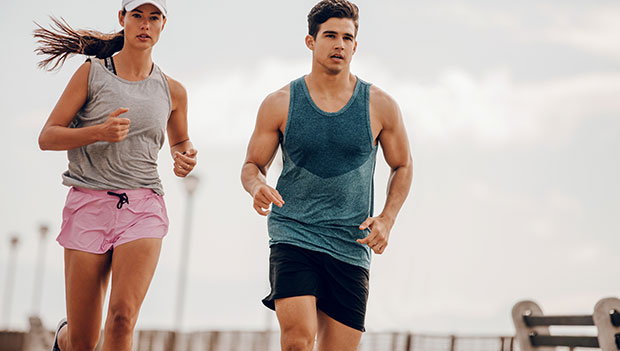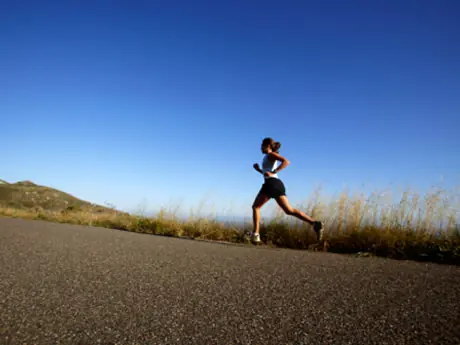
How to Start Running | Running Tips | Hydration for Runners | Best Running Shoes for Beginners | Most Comfortable Running Shoes | Best Sports Bras for Running | Best Running Jackets | Best Budget Treadmills | Best Budget Fitness Trackers
Many believe running is just putting one foot in front of the other more quickly than walking. But there's so much more to running than most people realize. Even if you aren't interested in running long distances or seriously training, there's plenty to learn. Whether you want to try racing or simply stay healthy, this guide will break down everything you need to get started with running. From the basics of proper form to the best gear, we'll help you get the most out of your workouts while also enjoying yourself.
How to Train
Ready to get started? It's best to run slower than you think you need to. In fact, during your first few weeks (or months) of running, walk breaks should be your best friend. Depending on your fitness level and experience, you may only need walk breaks occasionally, but if you're a true newbie, plan to start by walking more than you run. For example, try 30 minutes of this: three minutes of running followed by 30 seconds of jogging. As the weeks progress, increase the jogging time and decrease the walking breaks.
Another good point to remember is: that less is more when it comes to mileage! As a beginning runner, you don't need to run more than a few days a week. Start slowly to avoid injury and burnout and make time for complementary activities such as strength training, cycling, or swimming.
If you've never run recreationally, it can feel awkward at first. Remember to keep an easy pace—you shouldn't feel out of breath right away! Other aspects of proper running form include keeping shoulders down and back, a slight forward lean with your hips, and relaxed hands. Focus on keeping things loose—could you hold a potato chip in your hands without crushing it? By staying relaxed, you'll save energy and start working toward increasing your endurance. You'll also want to try and have "quick feet." A high turnover rate—or cadence—is more efficient and causes less impact on the body.
After you've figured out the basics, aim to complete two to three run-walks per week. By the end of a month, we can almost guarantee things will start to feel easier. Once you're in a groove, consider setting a goal. Maybe it's finishing one mile without walking, running a local 5k, or completing 40 miles.
Training Plans
If you decide to train for a race—or work on endurance and speed—it might be time for a training plan or a basic running app. There are plenty of options available online for free, but if you're looking for more specificity, a virtual coach or an in-person running group can be a great way to progress as a runner.
Before you commit to a plan, a coach, or a group, ask yourself some key questions: what do you want to get out of this experience? How much time can you reasonably commit to running? What special considerations should the plan or coach take into consideration? For example, some runners do well with a weekly training routine—for example, Monday through Sunday—while others need a bit more time to fit in all the necessary workouts. In this case, a 10-day training block might work best. A good plan will help you balance increases in duration and intensity with easy runs and step-back weeks.
A running coach might sound like something only super-fast runners have, but we can guarantee that almost anyone can benefit from some direction. A good coach or training plan can help you determine how fast and how often you should run. Both are key factors in avoiding injury and building up endurance. Having a plan in place can also prevent you from overdoing it or give you the push you need if your motivation wanes.
Gear
From a gear standpoint, an essential item that you'll need to begin running is a good pair of shoes. You can get fitted at a local running store or buy a pair online (be sure to double-check the return policy!). If you're new to the sport, it's probably best practice to go to an in-person retailer to get fitted and try on a few different styles.
Once your shoes are in order, a good pair of socks will keep you blister-free and comfy. For example, the Bombas Running Ankle Socks are made from moisture-wicking materials to avoid sweat build-up—the leading contributor to blisters. They're also thin and breathable, so you can spend more time thinking about your goals and less time thinking about your feet!
If you're a female runner, you'll probably want a supportive sports bra. Lululemon's Like A Cloud Longline Sports Bra is great for easy runs or lower-impact cross-training days if you don't need extra support. For men, something like the Dash T-Shirt by Nathan is moisture-wicking and breathable—necessary for sweaty runs!
For warmer runs, you'll also need a pair of shorts. The exact type will depend on your body and preferences, but tight-fitting and moisture-wicking materials will generally prevent chafing. For sunny running, don't forget a hat with a brim and a pair of sunglasses with UV protection. Tifosi and Goodr make affordable sunglasses options for sweaty runners.
If running in colder temperatures, you'll want to consider winter gear like spandex tights, a long sleeve base layer, a hat, and gloves. Your level of outerwear will vary depending on climate, but the Jack Wolfskin Tasman Cloud Fleece Jacket is an excellent option for chillier runs, but not necessarily below freezing. While this may seem like a lot of gear, if you want to stay committed—and comfortable—during the colder months, these items are an essential investment.
Finally, if you want to track your run, you can do it with an app on your smartphone (Strava is popular), but when you're ready for more data, a running-specific watch like a Garmin or Coros can be a game changer.
Fuel
If you're running casually a few days per week, you can probably rehydrate with water and stick to your normal meal and snack routine. However, if you begin training for a race or are running for performance, it might be helpful to consider specialized products. For runners who sweat heavily, consider an electrolyte replacement drink such as Gnarly Hydrate. This beverage is low on sugar (unlike Gatorade and some other commercial options), NSF Certified sport, Vegan, and contains a good amount of electrolytes and B vitamins.
If you'll be running for over an hour, it's time to think about on-the-run nutrition. Many runners like Gu gels and/or Honey stinger energy chews. They come in a ton of flavors and some contain caffeine for an added energy boost. If you can't stomach solids while running, you might want to consider a liquid carbohydrate replacement option such as Gnarly Fuel20.
Athletes will also want to pay attention to post-run recovery and prioritize a combination of carbohydrates and protein to aid in muscle protein synthesis. There are tons of protein powder options on the market (whey and plant-based), but you can also just combine a Greek yogurt with a banana for a similar effect.
If you're feeling overwhelmed by all the products and gear, just remember—you can start simply. That's one of the beautiful things about running! Get a good pair of shoes, go for a few easy runs, and then decide what you really need or want.
How to Start Running | Running Tips | Hydration for Runners | Best Running Shoes for Beginners | Most Comfortable Running Shoes | Best Sports Bras for Running | Best Running Jackets | Best Budget Treadmills | Best Budget Fitness Trackers
Get ACTIVE on the Go


Couch to 5K®
The best way to get new runners off the couch and across the finish line of their first 5K.
Available for iOS | Android







Discuss This Article